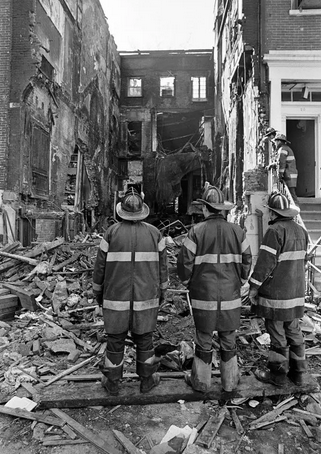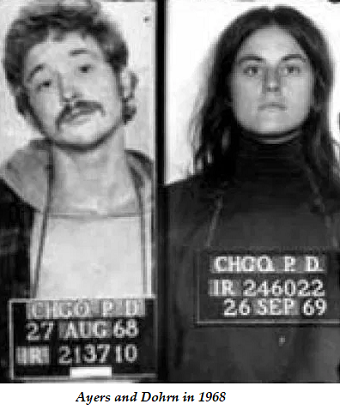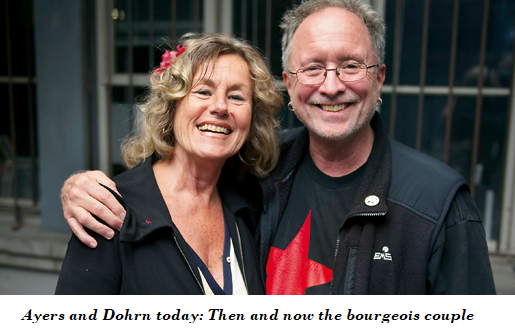White Self-Hatred and the Cancel Culture Mervyn Bendle
” Where did it come from, this eruption of rioting and demands that statues and history be torn down? Well, much as the Black Lives Matter crowd might seem of recent origin, it is the Sixties where it all began.”
Violent, uncontrolled demonstrations, vicious attacks on the police, bitter condemnations of ‘white privilege’, the comprehensive ‘cancellation’ and fabrication of history, and the destruction and vandalization of historical monuments under the umbrella of the Black Lives Matter campaign have become central features of the current radical assaults on Western societies.
The massive involvement of semi-hysterical young white people is one of the most striking features of this ‘cultural revolution’. Anxious to be associated with black protesters in the vanguard of destruction and chaos, they run back and forth in their designer black ‘Ninja’ outfits, elegantly masked, shrieking abuse and baiting police, throwing stones and Molotov cocktails, attacking bystanders, inanely kicking and punching toppled statues as they push them into drains, and smashing shopfront windows to loot items their parents would buy them without a second thought. And then, on social media they attack viciously anyone who dares to disagree with them or question how their over-hyped involvement helps the campaign for racial justice.
In seeking to understand this frenzied phenomenon of ostentatious self-abnegation it is necessary to discuss its ideological and activist origins in the far-left terrorist groups of the Sixties. This venture into history might serve to forewarn where this might all be heading.
At the centre of this history are the Weathermen (aka the Weather Underground). This was a far-left radical organization that advocated urban guerrilla warfare and terrorism to sow the seeds of a revolutionary upheaval in America and its allies, such as Australia. Their aims were stated in their manifesto (named after a Bob Dylan lyric): “You don’t need a weatherman to know which way the wind blows’. This 16,000-word diatribe identifies “the contradiction between the revolutionary peoples of Asia, Africa and Latin America and the imperialists headed by the United States as the principal contradiction in the contemporary world.”
The enemy was their own society, which they committed themselves to destroying from within. As they declared in one of their early pamphlets using a deliberate misspelling of ‘AmeriKKKa’ meant to denote its racist and fascist nature:
We move with the people of the world to seize power from those who now rule … We’ve got to actively fight. We’re going to bring the war home to the mother country of imperialism. AMERIKKKA: THE FINAL FRONT … We start to build a Red Army by fighting in the streets now. We’re going to knock the pig on his ass in those streets.
They were a determined Fifth Column, relying on the self-hatred engendered in their own country by the left’s control over education. According to one of their leaders, Bernardine Dohrn:
All over the world, people fighting Amerikan imperialism look to Amerika’s youth to use our strategic position behind enemy lines to join forces in the destruction of the empire … Our job is to lead white kids into armed revolution … Che Guevara taught us that ‘revolutionaries move like fish in the sea’. The alienation and contempt that young people have for this country has created the ocean for this revolution.
The defining psychological feature of the Weathermen was their hated and guilt about being white. They felt a desperate need to atone for their “white skin privilege”, as they put it in a formula that now has an iron grip on universities and the media. Consequently, their ideology and practice were characterized by a rejection of the white working class as racist, and their embrace of Black Power and Third World revolutionary movements as the only legitimate motors of historical progress.
Initially, the Weathermen focused on ideological work. For example, they launched an agitprop campaign in schools, urging white working-class students to join ‘The Revolution’, much as one of the co-founders of the Black Lives Matter organisation did recently at a school in Cabramatta, explaining to the students that “we are trained Marxists [with] an ideological frame” that reveals capitalism to be the main evil threatening the world. (paywalled: “Radical question Marx over BLM movement’s aims”, Daily Telegraph, 20/6)
The Weathermen organized squads to barge into blue-collar high schools in Pittsburgh, Milwaukee, Boston, and other cities. Yelling ‘Jailbreak!’ they pushed teachers aside, even tied them up and gagged them, before delivering their revolutionary message. As one Weathermen leader declared: “The kids would learn that their only choice is either joining the world revolution led by the blacks, the yellows, and the browns, or being put down as US imperialist pigs by the people of the Third World.”
However, the lukewarm response they received turned them to violence. They adored Che Guevara and modeled themselves after the Tupamaros, the ultra-violent Uruguayan urban guerrilla group. And so began the ‘Days of Rage’ in October 1969, as they carried out an extended campaign of violent demonstrations, riots, robberies, jail breaks, and bombings, including 250 major bomb attacks between September 1969 and May 1970.
As affluent, white, young university students they desperately sought credibility in the eyes of the Black Power activists whom they idolized. It was for this reason that they made extreme violence a non-negotiable tactic of all their activities, as they explained in one of their manifestoes:
We’ve got to show people that white kids are willing to fight on the side of black people and on the side of the revolution around the world. If you’re not going to fight, then you’re not part of us. It’s as simple as that.
And as one of their leaders, Bill Ayers, declared: “Kill all the rich people. Break up their cars and apartments. Bring the Revolution home, kill your parents.”
Committed to acts of exemplary violence to establish their revolutionary credibility, the Weathermen lived in a fantasy world of ultra-radical political posturing that progressed quickly from verbose polemical denunciations of Western society to deliberate street violence, vandalism and crime and, ultimately, to terrorism. Their pamphlets denounced all police as ‘pigs’, and they fantasized about killing them. As one Weatherman mused:
It’s a wonderful feeling to hit a pig. It must be a wonderful feeling to kill a pig or blow up a building. We’re against everything that’s ‘good and decent’ in honkey America. We will burn and loot and destroy. We are … your mother’s worst nightmare.
Their leaders fantasized about dying as heroes in a hail of police bullets, as vividly depicted in Bonnie and Clyde, Butch Cassidy and Sundance Kid, The Wild Bunch, and other popular movies from the period. Significantly, their first bombing destroyed a major Chicago monument to the police killed in the Haymarket Riots a century earlier. Later, they bombed a New York City police station, allegedly in retaliation for the death of a black activist who had been killed attempting a prison escape.
In addition to world communist revolution, the Weathermen called for the victory of communist North Vietnam in the Vietnam War and the creation of many Vietnam-like guerrilla wars around the globe, designed to consume all America’s military resources. The communist dictator of North Korea also attracted their adoration, and so they devised a song sung to the tune of ‘Maria’ from West Side Story:
The most beautiful sound I ever heard
Kim Il Sung …
I’ve just met a Marxist-Leninist named Kim Il Sung
And suddenly his line
Seems so correct and fine
To me
Kim Il Sung
Say it soft and there’s rice fields flowing
Say it loud and there’s people’s war growing
Kim Il Sung
I’ll never stop saying Kim Il Sung.
Kim Il Sung would have been delighted.
Inevitably, the Weather Underground became cultish and adopted the ritualistic public self-denunciations demanded in the Chinese Cultural Revolution. Members were forced to confess their mistakes or any thoughts that deviated from the group’s ideology. This ensured total ‘transparency’, especially of the rank-and-file to the leadership.
In the area of sexuality, their behaviour became pathological and can only be touched on here. Within the fanatical world of their ‘collectives’ the goal was to “smash monogamy” through various sorts of sexual experimentation, with all members, male or female, commanded to sleep with each other. One member wrote later of being ‘guilt-tripped’ into having sex with a black comrade to prove she wasn’t racist. Private relations of love and affection were declared exclusionary, counterrevolutionary and pathetically middle-class.
When some of the women had children, pressure was applied to ensure no bourgeois maternal attachments developed. Any ‘Weathermothers’ who were suspected of devoting too much time to their babies were forcefully reminded that the revolution came first and some were even ordered to give their babies away. Moreover, in line with their exaltation of Black Power, white babies were seen as tainted with the original sin of ‘white privilege’, while one ‘Weathermother’ was told as she breastfed her child that, “all white babies are pigs” and her baby should be put in the garbage.
The hideous violence associated with the Charles Manson-led Tate-LaBianca murders in 1969 appealed particularly to the Weathermen. Manson, like them, preached an upcoming race war, and they elevated him and his gang into revolutionary heroes. They kept a trophy picture of the brutally murdered Sharon Tate on their office wall. The new morality of Nihilism was expressed by Bernardine Dohrn in a notorious outburst:
Dig it. First they killed those pigs, then they ate dinner in the same room with them, then they shoved a fork into a victim’s stomach! Wild!
This exemplified the boundless hatred felt by the Weathermen for mainstream morality and society. Indeed, the leadership expected that they would have to direct a post-revolutionary extermination campaign, involving the killing of some 25 million Americans judged to be enemies of the new regime. As an incredulous witness to the discussion observed:
I want you to imagine sitting in a room with 25 people, most of whom have graduate degrees, from Columbia and other well-known universities, and hear them figuring out the logistics for the elimination of 25 million people.
 This madness finally reached a crescendo with a massive series of explosions in a New York City townhouse in March 1970. Three Weathermen were killed when a bomb they were constructing exploded, blowing them to pieces, destroying the four-story building (right), the wall of the house next door (owned by actor Dustin Hoffman), and shattering windows throughout the neighborhood. It had occurred when a Weatherman misconnected some wires while making anti-personnel pipe bombs composed of nails wrapped around sticks of dynamite. A search by police and firemen found evidence of at over 60 sticks of dynamite, 30 blasting caps, timing devices made from alarm clocks, and a quantity of twelve inch iron pipes packed with dynamite. Apparently, the bombs were to be used in a large scale bombing offensive, beginning with an attack on young army recruits and their dates at a social dance at Fort Dix, New Jersey.
This madness finally reached a crescendo with a massive series of explosions in a New York City townhouse in March 1970. Three Weathermen were killed when a bomb they were constructing exploded, blowing them to pieces, destroying the four-story building (right), the wall of the house next door (owned by actor Dustin Hoffman), and shattering windows throughout the neighborhood. It had occurred when a Weatherman misconnected some wires while making anti-personnel pipe bombs composed of nails wrapped around sticks of dynamite. A search by police and firemen found evidence of at over 60 sticks of dynamite, 30 blasting caps, timing devices made from alarm clocks, and a quantity of twelve inch iron pipes packed with dynamite. Apparently, the bombs were to be used in a large scale bombing offensive, beginning with an attack on young army recruits and their dates at a social dance at Fort Dix, New Jersey.
The bombing campaign nevertheless went ahead. Targets included the home of the judge who had presided over a trial of some Black Panther militants on conspiracy charges relating to the planned bombing of police stations, Macy’s department store, and the Bronx botanical gardens. Within months the group had bombed the Presidio Army Base in San Francisco, the Army Mathematics Research Center in Madison, Wisconsin (where a graduate student was killed), the Haymarket Memorial (for a second time), the Marin County Court House, the Long Island Court building, and the Centre for International Affairs at Harvard. Many more bombings occurred over the next few years. In the group’s later manifesto, Prairie Fire: The Politics of Revolutionary Anti-Imperialism, Bill Ayers, took credit for participating in some 30 bombings and other terrorist attacks, including on the US Capitol in 1971, and the Pentagon in 1972.
As one contemporary historian (who was himself a radical leader in the Sixties) has observed:
The Weathermen were traveling to the far reaches of loathing. Their immensely bad ideas and dreadful tactics must have had a root in some larger upheaval of the movement’s collective psyche. Charles Manson, the fork, the Weathermen as vandals and scourges – we had stumbled onto the realm of the demonic. — Todd Gitlin, The Sixties: Years of Hope, Days of Rage
Inevitably, the Weathermen were placed on the FBI’s 10 Most-Wanted list and Ayers, Dohrn and the rest went underground. During these ‘fugitive years’ Ayers claims to have lived in 15 states, using the names of dead babies in cemeteries who were born in the same year as he was, and living in safe houses full of books by Malcolm X and Ho Chi Minh, with Che Guevara’s picture on the walls. Ultimately he and Dohrn got married and used their wealth and high level contacts to escape justice for their terrorist activities.
 They remain unrepentant. In an interview published to promote his memoirs, Fugitive Days, which appeared in the New York Times on the very day of the 9/11 attacks, Ayers declared that “I don’t regret setting bombs, I feel we didn’t do enough”, and when he was asked directly whether he’d do it all again, he replied: “I don’t want to discount the possibility” At a reunion in December 2007, Ayers and Dohrn basked in their persona as triumphant rebels who had embraced ‘the spirit of resistance’ and risen to fame and influence. This included becoming vital political mentors to a young Barack Obama as he began his political career in Chicago — a relationship that resulted in claims Ayers ghostwrote slabs of the future president’s best-selling biography Dreams of My Father.
They remain unrepentant. In an interview published to promote his memoirs, Fugitive Days, which appeared in the New York Times on the very day of the 9/11 attacks, Ayers declared that “I don’t regret setting bombs, I feel we didn’t do enough”, and when he was asked directly whether he’d do it all again, he replied: “I don’t want to discount the possibility” At a reunion in December 2007, Ayers and Dohrn basked in their persona as triumphant rebels who had embraced ‘the spirit of resistance’ and risen to fame and influence. This included becoming vital political mentors to a young Barack Obama as he began his political career in Chicago — a relationship that resulted in claims Ayers ghostwrote slabs of the future president’s best-selling biography Dreams of My Father.
 Their wealth and influence ensured an affluent post-Weathermen lifestyle. Ayers recently retired as professor in the College of Education at the University of Illinois at Chicago, formerly holding the titles of Distinguished Professor of Education and Senior University Scholar. Dohrn also recently retired from a prestigious academic position: Clinical Associate Professor of Law at the Children and Family Justice Center at Northwestern University School of Law.
Their wealth and influence ensured an affluent post-Weathermen lifestyle. Ayers recently retired as professor in the College of Education at the University of Illinois at Chicago, formerly holding the titles of Distinguished Professor of Education and Senior University Scholar. Dohrn also recently retired from a prestigious academic position: Clinical Associate Professor of Law at the Children and Family Justice Center at Northwestern University School of Law.
They remain proud of never deviating from their far-left ideology and continue to embrace their white self-hatred and theory of ‘white privilege’ as a template for social and historical analysis. As they made clear in their influential 2009 book, Race Course: Against White Supremacy, white supremacy has been the dominant political system in the United States since its earliest days and permeates every aspect of society: the criminal justice system, the political system, policing, defence and foreign policy, and especially education. In that area they have long preached an ultra-progressive line that has proven very influential, especially on contemporary radicals, including those involved in BLM.
And so the madness of the Sixties reverberates today, engulfing society at a moment of acute crisis. Amidst chaos and nihilism, ordinary folk must struggle on, seeking to earn a living and make something of their lives while trying to support and nurture their families. Meanwhile fanatical ideologues are allowed to run amok, replaying the madness of the past. Indulged by a petrified establishment, they attract massive media attention, ostentatious acts of sympathy, and even support from the leaders and institutions of the very society that they hold in contempt and are working feverishly to undermine and overthrow.
Comments are closed.
